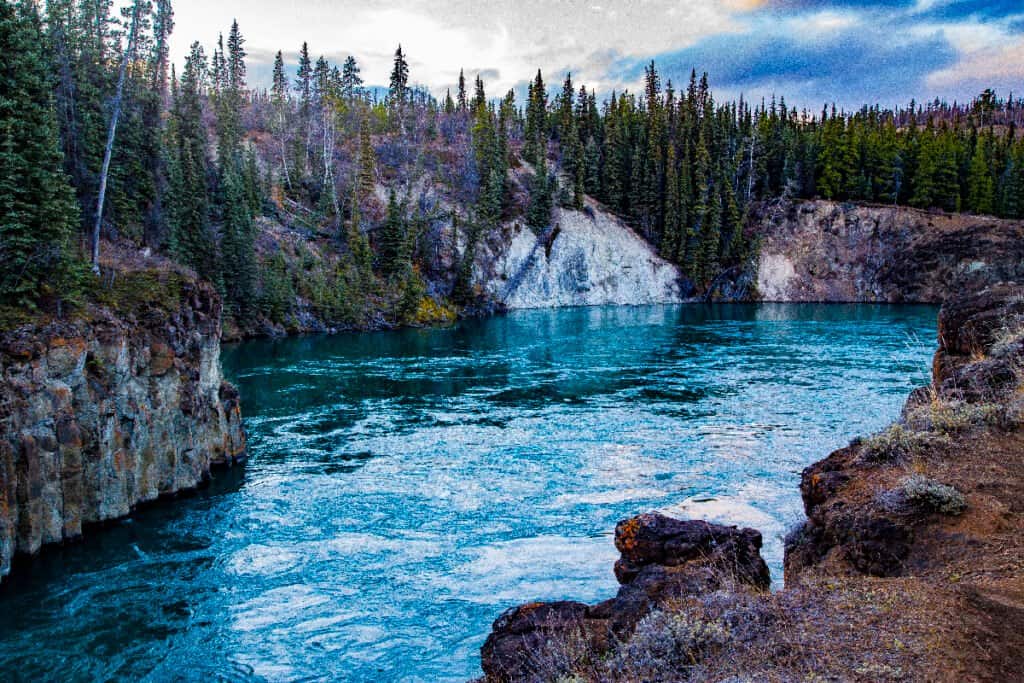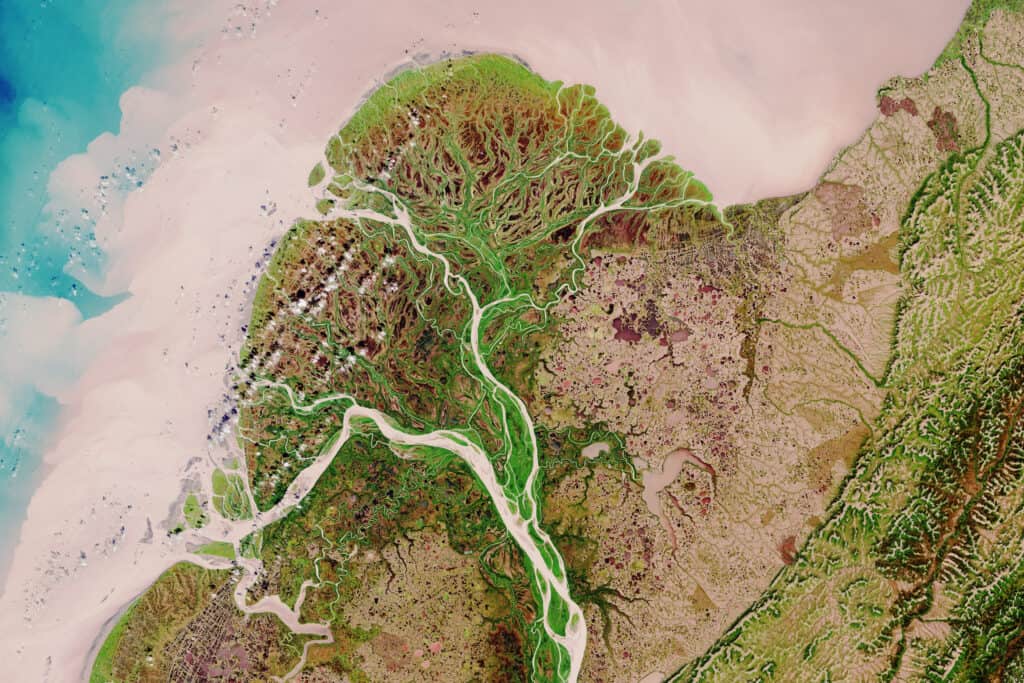The Yukon River is the largest river in Alaska and the Yukon, Canada. The river was so important to the area that the Yukon gets its name from the river. From 1896 to 1903, thousands of people traveled the river during the Klondike Gold Rush. Prior to then, numerous indigenous tribes relied on the river for food and as a means of transportation. Today, the Yukon River continues to support one of the longest salmon runs in the world.
In this article, we’ll explore the course of the Yukon River. We’ll discover where it rises, where it flows, and where the Yukon meets its end. Finally, we’ll examine what makes the river such an important historical landmark and some of the threats it faces.
Where Does the Yukon River Start?

The Yukon River starts from the Llewellyn Glacier.
©iStock.com/HeatherECampbell
According to most experts, the waters of the Yukon River stem from the Llewellyn Glacier. The Llewellyn Glacier is the second-largest glacier in the Juneau Icefield and rests at the southern end of Atlin Lake in British Columbia. However, some argue that Lake Lindeman serves as the source of the river. Regardless, both Atlin Lake and Lindeman Lake flow into Tagish Lake in northern British Columbia. Subsequently, Tagish Lake feeds into Marsh Lake, whose northern end represents the official start of the river. No matter which theory you subscribe to, the result ends up the same.
From its source, the Yukon River runs north past the Yukon capital city of Whitehorse. Shortly thereafter, it widens into Lake Laberge. Numerous rivers and streams act as tributaries to the Yukon River. In Canada, the major tributaries include the Teslin River, Pelly River, White River, and Stewart River. Meanwhile, the primary tributaries in Alaska include the Porcupine River, Tanana River, and Koyukuk River. All told, more than 50 rivers, streams, and creeks flow into the Yukon River.
What Places Does the Yukon River Flow Through?
The Yukon River may start in northwestern British Columbia, but the majority of the river resides in the Yukon and Alaska. Shortly past its source, the river enters the Yukon. From there, it travels northwest through the territory until it reaches the eastern border of Alaska near the town of Eagle. The river then cuts westward and continues to flow through the state toward the Bering Sea. Along its course, the river passes several towns and cities, including Whitehorse, Dawson City, Eagle, Circle, Fort Yukon, Stevens Village, Rampart, Tanana, Ruby, Galena, Nulato, Grayling, Holy Cross, Marshall, St. Mary’s, and Mountain Village. The Yukon River also passes through several parks, including Innoko National Wildlife Refuge, Yukon-Charley Rivers National Preserve, and the Yukon Delta National Wildlife Refuge. Approximately 900 miles of the river flows through Canada, while the remaining 1,400 miles reside in Alaska.
Where Does the Yukon River End?
After it enters Alaska, the Yukon River slowly winds its way west. Upon reaching Mountain Village, Alaska, the Yukon branches out into many separate channels. Known as the Yukon-Kuskokwim Delta, the delta covers a territory of 321,500 square miles. This makes the Yukon-Kuskokwim Delta one of the largest river deltas on Earth. All the various channels of the delta eventually empty into the Bering Sea, the body of water that separates the Americas from Eurasia. Numerous small communities lie within the delta, including Nunam Iqua, Alakanuk, Emmonak, and Kotlik. In total, approximately 25,000 people live within the Delta, 85% of whom are Alaska Natives.
How Long is the Yukon River?

The Yukon River measures approximately 1,980 miles long.
©lavizzara/Shutterstock.com
From start to finish, the Yukon River measures approximately 1,980 miles long. It rises in northern British Columbia, flows northeast through the Yukon, and then travels west through Alaska. The river eventually empties into the Bering Sea at the end of its nearly 2,000-mile journey.
At its source, the Yukon River begins nearly 2,195 feet above sea level. It drops on average a little over 1 foot every mile until it finishes at sea level. Meanwhile, the average flow of the river is between 230,000 and 250,000 cubic feet per second. The river drains an area of approximately 321,500 square miles, an area roughly the size of the Ivory Coast.
Is the Yukon River the Longest River in the Region?
The Yukon River easily ranks as the largest river in Alaska, the Yukon, and British Columbia. That said, some people don’t count the Yukon River as the longest river in British Columbia. This likely stems from the fact that only a very small part of the river resides in British Columbia. Using this point of view, the Fraser River – which resides entirely in British Columbia – ranks as the longest river in the province. Still, in terms of total length, the Yukon River (1,980 miles) measures more than double the Fraser River (854 miles). In Canada, only the Mackenzie River (2,635 miles) exceeds the Yukon River in length. That makes the Yukon River both the second largest river in the Canadian territories and Canada at large.
Why is the Yukon River Important?
For thousands of years, indigenous peoples lived along the banks of the Yukon River. These communities relied heavily on the river for food, primarily in the form of salmon. The river supported many tribes, including the Yup’ik, Gwich’in, Hän, Denaakk’e, and Southern Tutchone. To these people, the river satisfied not just material needs, but also played an important spiritual and cultural role as well. During the Klondike Gold Rush of 1896-1903, nearly 100,000 prospectors flooded into the Yukon in search of gold. Many people who traveled to the Klondike region arrived on paddle boats or other watercraft via the Yukon River. In honor of this event, the 30-mile section of the river between Lake Laberge and the confluence with the Teslin River is designated as a national heritage river.
The Yukon River supports a wide variety of plant and animal life. It hosts one of the longest salmon runs in the world. Coho, Chinook, and chum salmon all travel the Yukon River to return to their spawning grounds in Alaska, the Yukon, and British Columbia. The river also supports other animals, including grizzly bears, beavers, otters, muskrats, and myriad fish, birds, amphibians, and reptiles.
What Threatens the Yukon River?
Like most rivers, the Yukon River faces several existential threats. The primary challenges the river faces include pollution, climate change, and landscape alteration. For most of its history, the Yukon River was an almost pristine waterway. So much so that its name in some native languages translates to “white water river.” However, in recent years, pollution tarnished that once pristine reputation. In particular, the river suffered substantial pollution from military installations and mining operations. The river contains higher suspended sediment concentrations as a result of this toxic runoff, which affects the quality of the water and the animals and people that rely on it to survive. Today, the Yukon River Inter-Tribal Watershed Council advocates for monitoring and cleaning of the river to make sure it remains safe for both people and animals.
Up Next…
If you’re interested in learning more about rivers and waterways, check out these other amazing articles:
- Where Does the Yellowstone River Start and End?
- Where Does the Missouri River Start?
- What Lives At The Bottom of The Mississippi River?
- How Deep Is The Hudson River?
- Where Does the Ohio River Start?
The photo featured at the top of this post is © iStock.com/HeatherECampbell
Thank you for reading! Have some feedback for us? Contact the AZ Animals editorial team.






